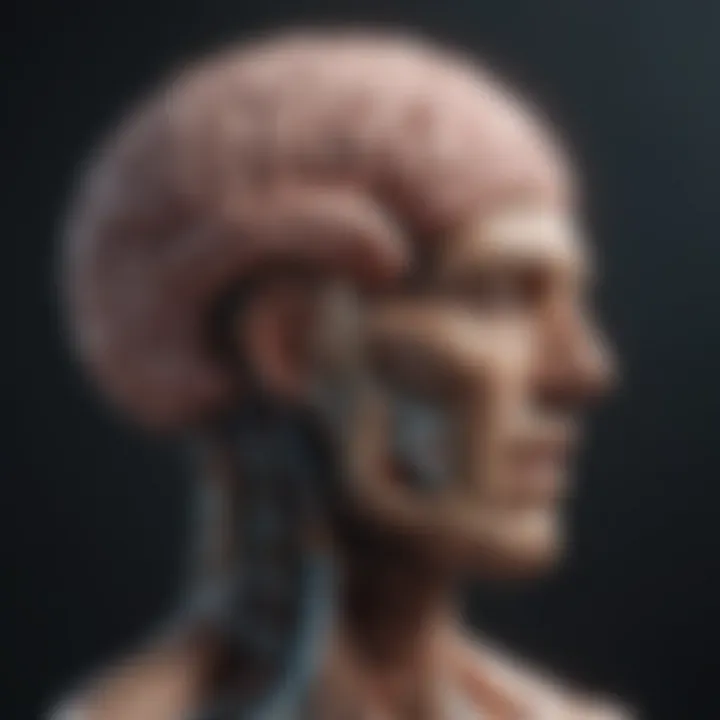Understanding Motion Sensitivity: Insights and Implications


Intro
Motion sensitivity is a complex phenomenon that not only challenges individual comfort but has broader implications for mental and physical health. This condition can manifest in different ways, affecting a wide range of populations. From those who experience discomfort in moving vehicles to individuals with vestibular disorders, the reactions can be profound. Understanding this issue requires a multidisciplinary approach that integrates psychological aspects with physiological responses.
As we delve into the mechanisms underlying motion sensitivity, it is important to recognize the significance of this condition in daily life. The implications extend beyond personal discomfort; they can impact social interactions, workplace performance, and overall quality of life. This article aims to examine the interplay of these factors, providing insights into current research and potential interventions.
Research Highlights
Overview of Key Findings
Recent studies on motion sensitivity have uncovered several key findings:
- Prevalence Across Populations: Research indicates a varied prevalence of motion sensitivity among different age groups and demographics, with certain populations being more susceptible.
- Psychological Impact: Emotional responses, including anxiety and discomfort, are frequently reported among those with motion sensitivity, highlighting the importance of psychological support alongside physical interventions.
- Physiological Mechanisms: Investigations into the vestibular and visual systems show that individuals with heightened motion sensitivity may process sensory information differently, which can explain their heightened discomfort.
Significance of the Research
Understanding motion sensitivity is crucial not only for the individuals who experience it but also for healthcare providers and educators. By recognizing the signs and symptoms associated with this condition, professionals can offer better support and tailored interventions.
Furthermore, this body of research contributes to a wider conversation about disability awareness and the importance of accessibility in various environments. It calls for a re-evaluation of how we accommodate those affected by motion sensitivity in public transport, workplaces, and educational institutions.
Original Research Articles
Summary of the Article
The original research articles exploring motion sensitivity provide a detailed examination of the various factors affecting individuals. Comprehensive analyses underscore the importance of integrating physiological, psychological, and social factors into our understanding of this condition.
Author Contributions
Numerous researchers and professionals have contributed to the field of motion sensitivity. Their work spans across various specialties, emphasizing the importance of a collaborative approach to fully grasping this complex issue. This collaborative spirit aids in the development of effective interventions, enhancing our overall capability to assist those affected.
Prelude to Motion Sensitivity
Motion sensitivity is a multifaceted issue that deserves attention. Understanding the significance of this topic is essential because it directly impacts individuals' daily experiences and well-being. Motion sensitivity can manifest in many forms, affecting various aspects of life. Given its prevalence, it is crucial to explore how it influences individuals psychologically and physiologically. The implications stretch beyond personal discomfort; they can shape social interactions, occupational opportunities, and overall quality of life.
In this section, we will delve into two primary aspects: defining motion sensitivity and examining its prevalence and demographics. By gaining insight into these key areas, we establish a foundation for further exploration of the mechanisms, implications, and interventions related to motion sensitivity.
Defining Motion Sensitivity
Motion sensitivity, at its core, refers to an intense physical and psychological response to motion, whether induced externally by environmental factors or internally through one’s own movements. Common symptoms include dizziness, nausea, confusion, and an overall discomfort in various scenarios such as being in a vehicle, watching moving visual stimuli, or engaging in certain dynamic activities.
This phenomenon can often be associated with conditions such as motion sickness, which specifically targets disturbed equilibrium during motion. However, it transcends mere discomfort. People experience motion sensitivity differently; the severity and triggers can vary greatly among individuals. This variability adds complexity to the understanding of the condition.
Prevalence and Demographics
In terms of prevalence, motion sensitivity is more common than many realize. Studies indicate that approximately 10% to 30% of the population might suffer from some form of motion sensitivity, depending on the environment and specific conditions present. These figures suggest that a considerable segment of society could potentially be affected without recognition.
Demographically, motion sensitivity does not discriminate widely; however, certain groups show higher susceptibility. For instance, children are often more vulnerable due to their developing vestibular systems. Pregnant women and older adults may also experience increased sensitivity due to physical changes.
Understanding the demographics and prevalence of motion sensitivity allows healthcare providers, educators, and researchers to tailor interventions and support, addressing the problem effectively. So, as we move further into the intricacies of motion sensitivity, it’s evident that a thoughtful exploration of its impact on various populations is crucial for advancing our collective understanding of this complex issue.
"Addressing motion sensitivity is not merely about alleviating discomfort; it's about enhancing quality of life."
Overall, motion sensitivity remains an important area of study with significant implications for various aspects of life.
Physiological Mechanisms of Motion Sensitivity
Understanding the physiological mechanisms of motion sensitivity is crucial for grasping how individuals react to movement and why some are more affected than others. This section delves into the complex interplay between various systems in the body that contribute to motion sensitivity, highlighting their significance in everyday life.
The Role of the Vestibular System
The vestibular system plays a fundamental role in maintaining balance and spatial orientation. Located within the inner ear, this system comprises structures called semicircular canals and otolith organs. These components detect changes in head position and motion. When an individual is exposed to motion, the vestibular system sends signals to the brain, informing it of the body's position in space.
In those who are sensitive to motion, the vestibular system may process these signals differently. For instance, if there is a disconnect between what the eyes see and what the inner ear perceives, it can lead to symptoms of motion sickness. This discrepancy can cause confusion for the brain, leading to discomfort or even nausea while moving.
Research indicates that the vestibular system not only contributes to physical balance but also affects cognitive processes. For example, individuals with vestibular dysfunction often experience difficulties in spatial awareness, which can complicate daily activities such as driving or navigating crowded spaces.
Neural Pathways Involved
Neural pathways related to motion sensitivity involve intricate networks that connect the vestibular system with other brain regions. The brain processes sensory information from the vestibular system among inputs from visual and proprioceptive systems. These pathways are essential for creating a coherent perception of motion. Disturbances in these pathways can lead to heightened sensitivity to movement.
For example, the vestibular nuclei in the brainstem receive inputs from the inner ear, while also integrating visual cues from the eyes and proprioceptive data from muscles and joints. This integration is vital during motion. If these signals synchronize properly, individuals can respond effectively. However, when there is a misalignment in these signals, it can produce symptoms such as dizziness or unsteadiness, which are common in motion-sensitive individuals.
Sensory Integration Processes
Sensory integration is the process by which the brain combines input from different sensory modalities to create a comprehensive understanding of the environment. In the context of motion sensitivity, this involves the synthesis of data from the visual, vestibular, and proprioceptive systems. Effective sensory integration allows individuals to understand their movements and interactions within a given space.


In motion-sensitive individuals, sensory integration may be impaired, leading to difficulty in accurately interpreting sensory inputs. This impairment can exacerbate symptoms like nausea and vertigo triggered by certain movements. Furthermore, factors such as age, environmental influences, and even genetic factors can further complicate these sensory integration processes.
Overall, recognizing the physiological components involved in motion sensitivity provides insight into how this phenomenon affects individuals. Understanding these mechanisms lays groundwork for potential interventions and helps illuminate the daily challenges faced by those with heightened motion sensitivity.
Psychological Dimensions of Motion Sensitivity
Motion sensitivity extends beyond physical discomfort. It includes profound psychological dimensions that impact individuals' everyday experiences. Understanding these dimensions is crucial for recognizing how motion sensitivity contributes not just to physical reactions but also to cognitive and emotional responses in people.
Cognitive Factors Influencing Sensitivity
Cognition plays a pivotal role in how individuals perceive and react to motion. Certain cognitive processes, like attention and perception, can enhance or mitigate motion sensitivity. People with heightened awareness of environmental stimuli tend to be more sensitive since they process motion signals more intensely.
For instance, individuals focusing on navigating through crowded public transport may experience intensified discomfort, as their cognitive load increases. Research indicates that anxiety and fear can further amplify this sensitivity. Cognitive-behavioral patterns, thus, significantly shape the sensitivity experience, making some individuals more prone to motion-related discomfort compared to others.
Impact on Mental Health
The relationship between motion sensitivity and mental health is significant. Chronic sensitivity can lead to anxiety disorders, as individuals may avoid situations where they anticipate discomfort. This avoidance can hinder social interactions and restrict mobility, potentially leading to conditions such as agoraphobia.
Moreover, the frustration of dealing with recurring episodes of motion sickness can contribute to a decline in overall mental well-being. The psychological burden can influence self-esteem and social engagement. It is paramount to recognize these connections, as they can inform better interventions aiming to alleviate not just motion discomfort but its psychological repercussions.
Affective Responses to Motion
Affective responses to motion include emotional reactions that vary from mild discomfort to severe distress. Individuals may experience feelings of unease or dread when faced with motion stimuli. These affective responses can be automatic and often lead to panic in sensitive individuals.
The intensity of these emotional reactions depends on various factors, including the environment and prior experiences. For example, someone who has previously experienced severe motion sickness on a roller coaster may feel anxious even at the mere sight of an amusement park. Understanding these emotional responses can be instrumental in creating effective therapeutic and preventive strategies.
"Recognizing the emotional and cognitive aspects of motion sensitivity is essential for developing holistic intervention strategies.“
In summary, the psychological dimensions of motion sensitivity shape the way individuals experience and cope with this phenomenon. By exploring cognitive influences, mental health impacts, and affective responses, we can build a comprehensive understanding, which is necessary for devising effective treatments and support systems.
Types of Motion Sensitivity
Understanding the various types of motion sensitivity is essential for recognizing its multifaceted nature. Each type reflects specific responses to motion stimuli, which have distinct implications for individuals. This classification can guide interventions and management strategies. Grasping the nuances of these variations helps in tailoring support and fostering better coping mechanisms among those affected.
Motion Sickness
Motion sickness is a prevalent condition often experienced during travel, such as in cars, planes, or boats. Individuals may feel dizzy, nauseous, or even vomit as their body struggles to reconcile conflicting sensory messages. The vestibular system, responsible for maintaining balance and spatial orientation, often gets overloaded during these experiences.
"Motion sickness occurs when there is a disconnect between the sensory input from the inner ear and the visual information received by the eyes."
For many people, understanding the triggers of motion sickness is crucial. Some common triggers include:
- Rapid movements: Sudden acceleration or deceleration can lead to discomfort.
- Visual stimuli: Watching a screen or reading while in motion can worsen symptoms.
- Environmental factors: Poor ventilation or strong odors may exacerbate feelings of sickness.
Sensitivity to Visual Motion
Another type of motion sensitivity is related to visual stimuli. This condition is often characterized by heightened responses to moving images, such as those encountered in video games, simulations, or even daily life transitions. Individuals may experience discomfort, headaches, or disorientation when exposed to rapidly changing images.
This sensitivity can hinder activities that involve quick visual processing or frequent shifts in attention, such as:
- Watching fast-paced sports: Quick movements can overwhelm the visual system.
- Playing action video games: Rapid changes can provoke symptoms.
- Using virtual reality environments: Some users experience intense responses to virtual motion.
Vestibular Disorders
Vestibular disorders encompass a range of issues related to the vestibular system, which manages our balance and spatial orientation. Conditions such as Benign Paroxysmal Positional Vertigo (BPPV), Meniere's disease, and vestibular neuritis can significantly impact an individual's quality of life. Symptoms may include vertigo, imbalance, and difficulty focusing in motion.
People with vestibular disorders can find it challenging to navigate their environments. Key factors influencing these conditions often include:
- Age: Older individuals may experience a higher prevalence of vestibular issues.
- Previous injuries: Head trauma can lead to long-term vestibular problems.
- Comorbid conditions: Other health issues can complicate vestibular sensitivities.
Understanding these types of motion sensitivity is critical for fostering effective strategies for management and care. Addressing each type allows for a more targeted approach to mitigate the impact on daily living and improve overall well-being.
Factors Contributing to Motion Sensitivity
Understanding the factors contributing to motion sensitivity is crucial in comprehending its prevalence and impact on individuals. These factors can be categorized into three primary areas: genetic predispositions, environmental triggers, and age and gender differences. Each of these elements plays a role in how and why individuals may experience heightened sensitivity to motion.
Genetic Predispositions
Genetic predispositions refer to the inherited traits that can influence a person's reaction to motion. Certain individuals may carry genetic markers that heighten their sensitivity due to variations in the vestibular system or neural processing. For instance, research has shown that family history can predict the likelihood of developing motion sensitivity. This aspect is significant because understanding genetic links can guide researchers in developing targeted interventions.
Some points to consider regarding genetic predispositions include:
- Heritability: Studies indicate that motion sensitivity may run in families, suggesting an inherited component.
- Biological Markers: Identifying specific genes associated with motion sickness could lead to preventive measures.
- Individual Variability: While some may have a strong genetic inclination, others may not experience severe motion sensitivity, highlighting the complexity of this trait.
Environmental Triggers
Environmental factors significantly influence motion sensitivity. These triggers can vary widely, from physical surroundings to situational contexts. Individuals with motion sensitivity often react poorly to quick movements, busy visual patterns, or unstable surfaces. For example, someone may find it challenging to ride in cars or buses on winding roads, leading to nausea or discomfort.


Consider these aspects of environmental triggers:
- Motion Exposure: Frequent exposure to motion in certain environments, like amusement parks, can heighten sensitivity over time.
- Visual Input: Environments with complex visual stimuli can exacerbate motion sensitivity, interfering with the individual's ability to normalize their perception of motion.
- Sensory Input Integration: Difficulties in processing visual and vestibular input can result in significant discomfort, making it essential to assess environmental conditions for those affected.
Age and Gender Differences
Age and gender are critical factors in understanding who is most affected by motion sensitivity. Research indicates variations based on developmental stages and hormonal differences. Children may experience more motion sickness than adults, while women, especially during hormonal changes, may also report higher sensitivities.
Regarding age and gender differences, consider:
- Developmental Trends: Children often outgrow motion sensitivity, yet it can linger into adolescence and adulthood for some.
- Hormonal Influence: Variations in estrogen and progesterone levels in women can influence sensitivity, particularly during menstrual cycles or pregnancy.
- Adaptive Mechanisms: Older adults may develop compensatory mechanisms over time but may also face increased motion sensitivity due to aging-related vestibular decline.
Understanding these factors enables further exploration of tailored strategies to mitigate the impact of motion sensitivity.
The Impact of Motion Sensitivity on Daily Life
Motion sensitivity has far-reaching consequences in various aspects of an individual’s daily life. Understanding these impacts is crucial, as they influence not only how individuals function on a personal level but also how they interact with their surroundings. For those affected, the implications can extend into mobility, social interactions, and occupational responsibilities. Each aspect warrants attention to understand the collective burden that motion sensitivity places on individuals.
Effects on Mobility and Transportation
For individuals with motion sensitivity, travel can become a source of significant distress. Common transport methods such as cars, buses, and trains often induce discomfort or nausea. These sensations arise due to the differing inputs received by the brain when in motion.
- The vestibular system, which detects movement, may incorrectly interpret signals, causing a sense of imbalance.
- In many cases, the anxiety surrounding transportation can lead to avoidance behavior, limiting mobility completely.
- Even short journeys may feel overwhelming, further isolating individuals from social and professional opportunities.
This avoidance has tangible effects on the practicalities of daily living, from delaying essential appointments to limiting the ability to engage in leisure activities. Understanding this aspect is vital not only for affected individuals but also for service providers aiming to improve transportation experiences through better accommodations.
Social Interaction Challenges
Social interactions are critical for personal and professional development. However, individuals with motion sensitivity often face challenges going to social gatherings. The fear of feeling unwell from potentially triggering environments can lead to avoidance of outings, which fosters feelings of isolation.
- Such avoidance may affect relationships with friends, family, and colleagues, who may not fully grasp the extent of this condition.
- Communication about one’s limitations becomes essential. Misunderstandings can occur if those around are not educated about motion sensitivity.
- Social anxiety, rooted in the potential for discomfort and embarrassment, can act as a barrier to forming connections.
Addressing these challenges requires an understanding of individual limits and the development of strategies to create accommodating environments for social interactions.
Occupational Limitations
In the workplace, motion sensitivity can lead to significant obstacles. Individuals may struggle in roles that require travel or movement in dynamic environments.
- Positions that involve frequent commuting or motion, such as those in the transport sector or fieldwork, may become unfeasible.
- Even desk jobs can pose challenges, especially if the office layout includes movement or the use of certain equipment.
- Employers need to be aware and consider possible accommodations, such as flexible work arrangements or alternatives to travel-heavy roles.
The implications of motion sensitivity extend into career choices, affecting job security and satisfaction. Occupational limitations not only affect individual economic stability but can also impact broader workforce dynamics.
In summary, motion sensitivity profoundly influences mobility, social interactions, and occupational opportunities. Each aspect plays a significant role in shaping the overall quality of life for those affected. Recognizing and accommodating these challenges is crucial for both understanding and addressing the comprehensive impact of motion sensitivity.
Evidence-Based Interventions for Motion Sensitivity
Evidence-based interventions for motion sensitivity are crucial for effectively addressing this complex phenomenon. These methods aim to alleviate the symptoms and improve the quality of life for individuals affected by various forms of motion sensitivity. The integration of scientific evidence into therapeutic practices ensures that treatments are not only effective but also tailored to the specific needs of patients. Here, we examine different categories of interventions: pharmacological approaches, therapeutic strategies, and lifestyle modifications.
Pharmacological Approaches
Pharmacological interventions aim to manage symptoms of motion sensitivity through medication. Various classes of drugs are utilized, depending on the type and severity of symptoms. Common options may include:
- Antihistamines, such as dimenhydrinate, which can help reduce the sensation of nausea associated with motion.
- Anticholinergics, like scopolamine, are often prescribed for motion sickness and act on neurotransmitters to diminish the body’s response to motion.
- Benzodiazepines may be considered for severe anxiety connected to motion sensitivity, offering a calming effect.
The effectiveness of these medications can vary among individuals, highlighting the importance of personalized treatment plans. It is critical to consider potential side effects and the patient's medical history when prescribing these medications.
Therapeutic Strategies
In addition to pharmacological treatments, various therapeutic strategies can be employed. These approaches focus on integrating techniques that manage motion sensitivity through behavioral and physical therapy methods. Some effective strategies include:
- Cognitive Behavioral Therapy (CBT), which aids in addressing the anxiety related to motion sensitivity.
- Vestibular rehabilitation therapy helps in retraining the brain to process motion stimuli more effectively, providing significant relief for many individuals.
- Desensitization techniques gradually expose the individual to motion in a controlled setting, helping them adapt over time.
Engagement with healthcare professionals skilled in these therapies ensures individuals receive the right guidance and support, facilitating progress toward symptom management.
Lifestyle Modifications
Lifestyle modifications play a vital role in managing motion sensitivity. Adopting specific changes in daily routines can significantly improve one’s ability to cope with symptoms. Recommended modifications include:
- Dietary changes, such as avoiding heavy meals before travel and choosing ginger or peppermint, which can help alleviate nausea.
- Regular physical activity, particularly exercises that promote balance and coordination, can positively impact motion sensitivity.
- Mindfulness and relaxation techniques, which can help reduce overall anxiety and improve an individual’s response to motion.
Integrating these changes into one's life can complement other interventions, offering additional benefits for those living with motion sensitivity.
"A comprehensive approach that combines medications, therapies, and lifestyle changes often yields the best outcomes for patients facing motion sensitivity challenges."
Technological Innovations Addressing Motion Sensitivity


The exploration of motion sensitivity has evolved significantly in recent years, prompting the emergence of various technological innovations. These innovations address both the management and mitigation of the effects of motion sensitivity. They contribute significantly not only to enhancing individual comfort but also to improving quality of life. This section examines three key areas: wearable technologies, virtual reality therapies, and mobile applications. Each represents a critical aspect of current approaches to motion sensitivity.
Wearable Technologies
Wearable technologies have become prevalent in healthcare, especially regarding motion sensitivity. Devices like smart glasses or head-mounted displays can help individuals manage their environments better. For example, smart glasses can provide visual cues that assist with spatial orientation, reducing anxiety associated with movement. Such devices often incorporate sensors that track motion and environmental factors, offering real-time feedback.
Key benefits of these technologies include:
- Real-time Monitoring: Users can receive immediate updates on their condition.
- Personalized Adjustments: Wearables often allow customization based on individual sensitivity levels.
- Enhanced Engagement: On-the-go data collection leads to better engagement with users and caregivers.
These devices do come with considerations. For instance, there is a need to ensure comfort and usability in diverse settings. Additionally, education on how to use these technologies effectively is crucial for maximizing benefit.
Virtual Reality Therapies
Virtual reality (VR) therapies offer innovative ways to address motion sensitivity. By simulating environments, users can gradually acclimate to their triggers in a controlled manner. This exposure therapy can aid individuals in developing coping strategies to manage their sensitivity to motion. Studies show that VR can effectively reduce symptoms associated with conditions like motion sickness.
Some advantages include:
- Controlled Environment: Users can face their fears in a safe context.
- Immersive Experience: It often engages multiple senses, promoting deeper learning.
- Adaptability: Programs can be tailored to individual needs, making it a flexible option.
However, implementing VR therapies requires careful design and oversight. For some, immersive simulations can initially provoke discomfort rather than alleviate it. Therefore, gradual exposure and proper guidance from professionals are recommended.
Mobile Applications for Management
Mobile applications are an accessible tool for individuals dealing with motion sensitivity. These apps can assist with tracking symptoms, providing educational resources, and suggesting coping techniques. They empower users to take a proactive stance towards managing their conditions.
Essential features often include:
- Symptom Tracking: Users log instances of motion sensitivity, identifying patterns and triggers.
- Educational Content: Many apps offer guidance on understanding motion sensitivity.
- Community Support: Some platforms incorporate forums where users connect with others facing similar challenges.
The effectiveness of mobile applications hinges on user engagement and developer support. Regular updates and responsive design can enhance usability and user satisfaction.
Technological innovations provide promising avenues for individuals affected by motion sensitivity. Each option presents unique advantages and challenges. The careful integration of these technologies into daily life is essential to optimize their impact.
In summary, the intersection of technology and motion sensitivity offers substantial potential for improvement in management and quality of life. Wearable technologies, virtual reality therapies, and mobile applications each contribute distinctly to enhancing the understanding and coping mechanisms surrounding this complex phenomenon.
Future Directions in Motion Sensitivity Research
Understanding motion sensitivity is crucial as it impacts daily life for many people. This section highlights future directions in research within this field, addressing emerging trends, interdisciplinary approaches, and the potential for personalized interventions. Fostering further investigation may result in more effective strategies to reduce the burden of motion sensitivity.
Emerging Research Trends
Currently, the trend is shifting towards a more intricate understanding of the physiological and psychological aspects of motion sensitivity. Researchers are exploring the connection between various disorders, including anxiety or vertigo, and sensitivity to motion. These studies are emphasizing the importance of understanding individual differences in susceptibility.
An important focus is on the role of genetics in motion sensitivity, as emerging studies suggest varying levels of sensitivity may relate to inherited traits. Investigating environmental influences is also a growing area, such as how urbanization and technology affect sensory experiences.
Interdisciplinary Approaches
Motion sensitivity research benefits from collaboration between different fields. Neuroscience, psychology, and engineering each contribute unique perspectives. Insights from neuroscience help clarify underlying neurological mechanisms. Psychology offers understanding about behaviors and strategies for coping. Engineering focuses on designing better technologies for analytics or interventions.
For example, combining findings from psychology and neuroscience can lead to the development of advanced therapeutic approaches. When disciplines work together, research and solutions can be more efficient and impactful.
Potential for Personalized Interventions
The future of interventions in motion sensitivity leans towards personalization. Recognizing that no two individuals experience motion sensitivity in the same way encourages tailored solutions. This could involve custom-designed therapeutic exercises or the use of wearable devices that monitor motion-related triggers.
Additionally, mobile applications could offer feedback and resources tailored to the user’s needs. This personalized approach could significantly improve quality of life for those affected by motion sensitivity, offering them greater control and understanding over their experiences.
"Future research must prioritize individual variation to provide nuanced solutions for those suffering from motion sensitivity."
Overall, the future of motion sensitivity research looks promising. As we explore these emerging trends and interdisciplinary strategies, it becomes clear that a comprehensive understanding is essential for developing efficient, personalized interventions.
Epilogue
The conclusion of this article serves as a vital element to synthesize the knowledge gained about motion sensitivity. In this section, it is essential to address the relevance of the findings and insights discussed throughout the article. Understanding motion sensitivity is not merely an academic pursuit; it holds real-world implications for those affected by this phenomenon.
One significant aspect is the impact on daily life. Individuals suffering from motion sensitivity often navigate challenges that can disrupt personal and professional environments. Therefore, acknowledging these struggles is crucial for fostering supportive scenarios.
Summary of Key Findings
Key findings from this research have illuminated several important points:
- Physiological Mechanisms: The vestibular system plays a central role in how individuals perceive motion.
- Psychological Dimensions: Cognitive factors significantly influence how motion sensitivity manifests in different people, which can also affect their mental health.
- Interventions: Both pharmacological and lifestyle modifications provide avenues for managing symptoms, but they are not universally effective for all individuals.
- Technological Innovations: Emerging tech, such as virtual reality therapies and wearable technologies, holds promise for future interventions.
The comprehensive overview presented sheds light on the intricate balance between physiological, psychological, and environmental factors affecting motion sensitivity. These elements can dictate how effectively individuals respond to their surroundings and the potential interventions that may work for them.
Final Thoughts on Motion Sensitivity
As a final point, it is crucial to recognize motion sensitivity not just as a medical condition, but as a multi-faceted issue that requires an interdisciplinary approach. The findings spur a call to action for researchers, healthcare professionals, and innovators.
There must be a concerted effort to improve awareness and understanding among the general public about motion sensitivity. This includes seeking ways to better support affected individuals through education, advocacy, and advanced research initiatives. Addressing these considerations can lead to better quality of life for those impacted. Furthermore, the potential for personalized interventions could enhance the effectiveness of treatment plans and improve life outcomes.
In closing, the exploration of motion sensitivity offers valuable insights. As research continues to evolve, the implications for future studies and practical applications will be significant, potentially changing not just how individuals with motion sensitivity function, but how society accommodates them.







